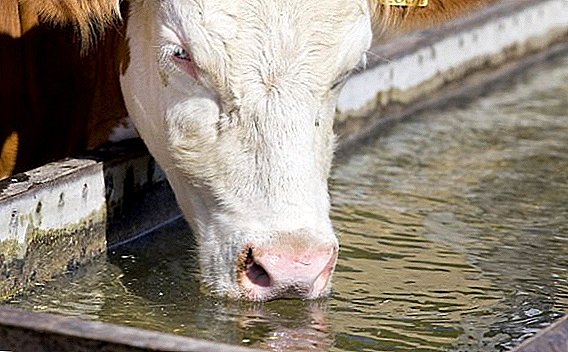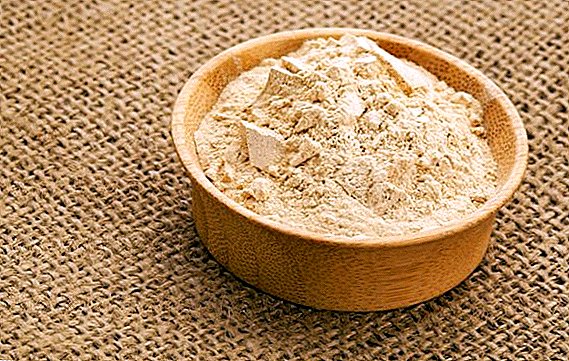 There are many different substances in the world that we may not even be aware of, while they are important components of certain products and materials. In this case, we will focus on the guar gum, which can often be found under the name "E 412". Let's find out what it is, what properties and features this food additive has.
There are many different substances in the world that we may not even be aware of, while they are important components of certain products and materials. In this case, we will focus on the guar gum, which can often be found under the name "E 412". Let's find out what it is, what properties and features this food additive has.
What is guar gum
Additive E 412 is included in the list of thickeners, being an emulsifier and a stabilizer. According to physical characteristics, it is a white or slightly yellowish powder, characterized by a characteristic odor.  Possessing all the properties of polysaccharides, it dissolves perfectly, and if you take a closer look at the chemical composition of a substance, then it is easy to detect its similarity with a similar derivative of a carob tree (in the International Classification of Food Additives listed as E 410).
Possessing all the properties of polysaccharides, it dissolves perfectly, and if you take a closer look at the chemical composition of a substance, then it is easy to detect its similarity with a similar derivative of a carob tree (in the International Classification of Food Additives listed as E 410).
Guar gum is a polymer compound with residual parts of galactose, and guaran is very rigid and elastic. Due to this, the additive is considered an excellent emulsifier and is highly resistant to cyclic freezing and thawing.
Did you know? The guar tree was recognized as a raw material for the production of natural additives in 1907. Since then, it has been considered as fit for human consumption by both large cattle and man, although this plant has been cultivated in India and Pakistan for centuries.

Getting Guar Gum
The raw materials for the manufacture of the supplement E 412 are the beans of the Cyamopsis tetragonolobus tree, or more precisely, their seeds, from which the plant extract is obtained in industrial conditions (supplied in powder form).
The seeds of fifteen centimeter beans are simply ground, separating the endosperm in the crushing process, and then the resulting substance is sieved many times and crushed to the state of a homogeneous powder.
Bean also includes dolichos, broom, green beans, cowpea vegetable, peas, green beans.A multi-stage cleaning process allows to obtain a very finely ground gum grade, with a high content of galactomannan and high viscous properties.
Traditionally, about 80% of the world production of this substance falls on India, although now it is produced by other countries: Africa, Canada, America and Australia. 
Guar gum application
The characteristics of the guar gum allowed it to become an excellent raw material for use in various areas of human activity, including in the food and drilling industries.
Moreover, such an additive did not become redundant in the production of textiles, paper, cosmetics and even explosive materials. 
In the food industry
The relevance of the use of this additive in the production of food products is explained by the following merits of the product:
- The viscosity of the gum at the level of 5,000 centipoise or 3,500 centipoise in a standard mixture allows it to perform the role of an excellent stabilizer, increasing the viscosity and gelling properties of products (especially important in the meat and dairy industry for longer storage of products or increase their density).
- The ability to perfectly dissolve in water and good compatibility with many other hydrocolloids of plant origin (for example, locust bean gum, pectin or carrageenan) make it possible to successfully use the substance to improve the consistency of products.
- When freezing, this property of the additive, such as the ability to slow down the formation of ice crystals (especially important in the production of ice cream, yogurt or other chilled confectionery products), is also useful.
- With this substance, you can significantly improve the external characteristics of ketchup, seasonings and salads, and in practice, for this purpose it is added to drinks (syrups or juices), dry mixes for instant soups, canned fish and even special food for pets.
 In any case, guar gum is almost not absorbed by the intestines and blocks the feeling of hunger, while lowering the level of cholesterol and saturated fat.
In any case, guar gum is almost not absorbed by the intestines and blocks the feeling of hunger, while lowering the level of cholesterol and saturated fat.Beets, pears, sweet potatoes, royal jelly, white currants, apricots, pine nuts, zucchini are capable of lowering cholesterol levels.
In the drilling industry
Guar gum proved to be an excellent "helper" in the organization of oil wells, as it is able to limit the withdrawal of fluid from the drilling fluid and render the concrete clay used in it the properties of the suspension.
Important! The most dangerous food additive is monosodium glutamate, which is used to enhance the aromatic and taste properties of certain products. It acts on the body on the principle of a drug, and over time you may no longer feel the taste of products without it. Harm to the growing brain of children.With all this, it can be called a more affordable counterpart of many other thickeners used in drilling. However, it is impossible to ignore the disadvantages of the guar variety in this matter.
 So, it does not have a high level of thermal stability, so xanthan gum would be a better option, especially if operating temperatures exceed a value of +100 ° C.
So, it does not have a high level of thermal stability, so xanthan gum would be a better option, especially if operating temperatures exceed a value of +100 ° C.In some cases, this defect can be compensated by the use of hydroxypropyl derivatives of the substance, because they have the best thermal stability.
Guar gum is also used in cases when it is necessary to increase the amount of oil produced using hydraulic fracturing.
Under the influence of high pressure, a proppant is supplied to the well, the role of which is perfectly suited to sand, previously compacted with the mentioned guar, or with a solution of hydroxypropylguar.  With its help, it is possible to widen cracks in hard rocks in order to organize a smooth passage of gas or oil.
With its help, it is possible to widen cracks in hard rocks in order to organize a smooth passage of gas or oil.
But this is not all the possibilities of the guar gum in the world of the drilling industry.
Due to the ability to form relationships with borate and transition metal ions (Ti and Zr), its gelatinization is often observed, and after the end of the hydraulic fracture, the gel-like substance is torn down and tried to be washed to leave only a small amount of it.
It must be said that the use of E 412 in the drilling industry for the extraction of oil is one of the main modern directions of application of this substance. 
Did you know? Oil has been extracted by mankind for over 6000 years. Thus, in ancient Babylon, bitumen served people in construction and sealing, and the ancient Egyptians used very simple lighting lamps, in which oil was used as a fuel.
In other areas
Despite the widespread use in the food and drilling industry, which is quite popular, guar gum has been and remains in several other spheres of human activity.
For example, for medical purposes, this substance is actively involved in the creation of drugs for diabetics, in order to ultimately reduce the rate of digestibility of sugar in the intestine, as well as slow down the process of absorption of other medicines and various food additives.  The use of guar gum has also been noted in the manufacture of textiles and paper (especially used for dyeing carpets and in textile printing), although chemically modified gums are often used in the technique: for example, carboxymethylhydroxypropylguar or carboxymethylguar.
The use of guar gum has also been noted in the manufacture of textiles and paper (especially used for dyeing carpets and in textile printing), although chemically modified gums are often used in the technique: for example, carboxymethylhydroxypropylguar or carboxymethylguar.
If necessary, the addition of E412 can also be used to create explosives, although it is much more often used for cosmetic purposes.
Of course, manufacturers of luxury cosmetics rarely resort to the use of guar gum, but in the budget segment it is very, very in demand.
In the production of cosmetics they also use beeswax, peppermint, citronella essential oil, feathery Kalanchoe, lychee, marjoram, flax oil, mother and stepmother, and cashew.In the role of emulsifier, thickener and stabilizer, it can be found in a large number of gels and creams, both in hair care products and in products designed to maintain body beauty.
 The presence of guar gum in them provides good hydration of the skin, gently cleanses its upper layer and protects the skin from wind and sudden temperature changes.
The presence of guar gum in them provides good hydration of the skin, gently cleanses its upper layer and protects the skin from wind and sudden temperature changes.When exposed to hair, this supplement perfectly restores all damages, adding shine and natural strength to its hair.
If desired, guar gum can be included in homemade cosmetic recipes, but if you do not have experience using such products, then it is better to give preference to ready-made creams.
Impact on the human body
We are used to be wary of any food additives, which in many cases is a very correct decision. However, regular consumption of food with a moderate amount of guar gum will not harm the body, on the contrary, there is information about the benefits of E 412. 
In particular, it is capable of:
- dull the feeling of hunger;
- lower blood cholesterol levels;
- increase the efficiency of calcium absorption;
- remove pathogens and toxins from the body;
- have a laxative effect (especially true for constipation).
Gooseberry, black currant, black nightshade, burdock root infusion, white willow bark, sweet cherry, fennel have a mild laxative effect.That is, guar gum in its pure form and when used in moderate doses is a completely safe additive to food, of course, unless manufacturers specifically changed its original composition with the help of various chemical supplements.
Important! Contrary to popular belief, you should not use this supplement for dietary purposes. In the 1980s, people had already followed this path, as a result of which, due to excessive use of gum and insufficient fluid intake, deaths were noted. After some time, scientists were able to prove the low effectiveness of E 412 for dietary purposes.
 With an overdose of this supplement, dietary supplements in its composition may well lead to pain in the intestines, nausea, and increased gas formation.
With an overdose of this supplement, dietary supplements in its composition may well lead to pain in the intestines, nausea, and increased gas formation.In addition, special attention should be paid to the issue of possible drug compatibility (when taking any drugs), otherwise there is a serious risk of complications.
Simply put, do not be afraid of guar gum, but when it is used, it is better to observe precautions and not to abuse the additive.












